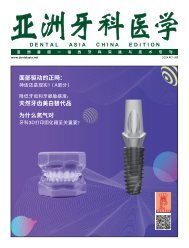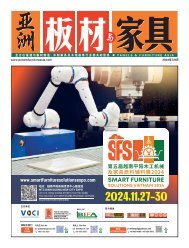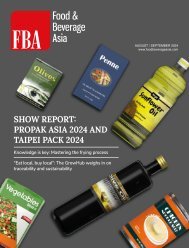Dental Asia May/June 2020
For more than two decades, Dental Asia is the premium journal in linking dental innovators and manufacturers to its rightful audience. We devote ourselves in showcasing the latest dental technology and share evidence-based clinical philosophies to serve as an educational platform to dental professionals. Our combined portfolio of print and digital media also allows us to reach a wider market and secure our position as the leading dental media in the Asia Pacific region while facilitating global interactions among our readers.
For more than two decades, Dental Asia is the premium journal in linking dental innovators
and manufacturers to its rightful audience. We devote ourselves in showcasing the latest dental technology and share evidence-based clinical philosophies to serve as an educational platform to dental professionals. Our combined portfolio of print and digital media also allows us to reach a wider market and secure our position as the leading dental media in the Asia Pacific region while facilitating global interactions among our readers.
Create successful ePaper yourself
Turn your PDF publications into a flip-book with our unique Google optimized e-Paper software.
Behind the Scenes<br />
AN EXCITING CHANGE<br />
– A Comparison of the IPS d.SIGN and<br />
IPS Style Ceramic Systems<br />
By Velimir Žujić<br />
Change is exciting – also in day-to-day dental lab<br />
work. The author switched to using IPS Style layering<br />
ceramic some time ago. Before he started working<br />
with this ceramic system, he thoroughly tested the<br />
material and compared it to the product he had<br />
previously used.<br />
The main aim of switching to a new ceramic system is to improve<br />
the quality of one’s results. We regularly used the fluorapatiteleucite<br />
glass-ceramic IPS d.SIGN® in our laboratory. Then, one<br />
day, we asked ourselves the following question: Would IPS Style®<br />
(the first patented metal-ceramic material containing oxyapatite)<br />
offer a sound alternative to our accustomed product? We decided<br />
to test the new material on flat cobalt-chromium alloy samples.<br />
These test specimens enabled us to take a closer look at the<br />
layering ceramic. We used these base metal alloy samples (Colado<br />
CC) to examine and compare several properties of IPS d.SIGN and<br />
IPS Style: For example shade, brightness, shrinkage, fluorescence<br />
and dimensional stability.<br />
Conditioning and opaquer application<br />
One specimen was oxidised at 950°C with a holding time of one<br />
minute. The other sample was treated with a bonding agent.<br />
Two metal specimens with different bases were now sufficiently<br />
prepared for the application of the ceramic materials. Next, the<br />
samples were coated with IPS d.SIGN Paste Opaquer and IPS Style<br />
Ceram Powder Opaquer. The opaquer products of both systems<br />
have a smooth consistency. We had never used an opaquer<br />
in powder form before, so applying the IPS Style material was<br />
completely new to us. Nevertheless, we were impressed by its ease<br />
of application and the excellent results.<br />
Shrinkage behaviour and shade effect<br />
In the next step, we compared Dentin and Transpa T Neutral<br />
materials as well as the Opal Effect OE1 materials. Each of the<br />
ceramics was applied to one of the metal samples. A line was drawn<br />
down the middle of the sample with a spatula for the purpose of<br />
comparing the shrinkage behaviour. The two different ceramics<br />
showed the same colour after firing. It was interesting to note that<br />
IPS Style exhibited less horizontal shrinkage than IPS d.SIGN (Fig.<br />
1). The vertical shrinkage of both ceramics was almost identical.<br />
The samples were held next to each other and examined under<br />
a polarising light. IPS Style was shown to be somewhat brighter<br />
than IPS d.SIGN. Both materials exhibited almost the same level<br />
of fluorescence. In this comparison, IPS Style was at a slight<br />
advantage because its Transpa T Neutral and the Incisal materials<br />
displayed a more lifelike fluorescence.<br />
Dimensional stability and test results<br />
The dimensional stability of the ceramics was clearly visible after<br />
the first firing cycle. The IPS Style layers successfully maintained<br />
their shape after firing. In contrast, IPS d.SIGN did not retain its<br />
shape completely. After this test series, we felt that we had gained<br />
enough information about the new material for our purposes. Even<br />
though the tests were relatively simple, they provided us with<br />
valuable insights into the two ceramic systems. Now, we are ready<br />
to compare the two materials on the basis of an actual case study.<br />
Fig. 1: Test samples showing shrinkage behaviour.<br />
Left: Application of the ceramic on the metal<br />
sample. Centre: IPS d.SIGN Right: IPS Style<br />
50 DENTAL ASIA MAY / JUNE <strong>2020</strong>


















